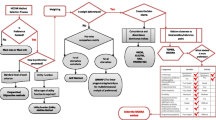Abstract
In this paper, the development of a methodology for the calculation of questions’ difficulty degree and creation of exams for distance education trainees is presented. The methodology is based on the principles of multicriteria decision analysis and multiobjective linear programming. The UTA* method is used in order to calculate the difficulty degree of any hypothetical question that can be described from the criteria defined and the Global Criterion method is used in order to solve the multiobjective mixed integer linear programming model that is constructed in order to create a test for the trainees.
Similar content being viewed by others
References
Beuthe, M., and Scannella, G. (2001), Comparative analysis of UTA multicriteria methods,European Journal of Operational Research, vol. 130, No 2, pp. 246–262
Bouyssou, D. (1990), Building criteria: A prerequisite for MCDA. In C.A. e Bana Costa, editor,Readings in Multiple Criteria Decision Aid, pages 58–80, Springer Verlag, Berlin
Delling, R.M. (1966), Versuch der Grundlegung zu einer systematischen Theorie desFernunterrichts, Fernunterricht, Edid. Sroka, L.,Festschrift zum 50 Geburtstag von Walter Schultz-Rahe, Hamburg: Hamburger Fernlehrinstitut.
Jacquet-Lagrèze, E., and Siskos, J. (1982), Assessing a set of additive utility functions for multicriteria decision-making: The UTA method,European Journal of Operational Research, (10), 2, pp. 151–164
Jacquet-Lagrèze E. and Siskos, J. (2001), Preference disaggregation: 20 years of MCDA experience,European Journal of Operational Research, vol. 130, No 2, pp. 233–245
Perraton, H. (1988), A theory for distance education, In D. Sewart, Keegan, D. & Holmberg, B. (Eds.),Distance education: International perspectives, pp. 95–113, New York: Routledge
Siskos, J. (2000), Linear Programming (Second edition) (in Greek), New Technologies Publications, Athens, pp. 371–416
Siskos, Y., Spyridakos, A., and Yannacopoulos, D. (1993), MINORA: A Multicriteria Decision Aiding System for Discrete Alternatives,Journal of Information Science and Technology, 2(2): 136–149
Siskos J., and Yannakopoulos, D., UTASTAR: An ordinal regression method for building additive value functions,Investigação Operacional, vol. 5, no 1, June 1985
Author information
Authors and Affiliations
Rights and permissions
About this article
Cite this article
Matsatsinis, N.F., Fortsas, V.C. A multicriteria methodology for the assessment of distance education trainees. Oper Res Int J 5, 419–433 (2005). https://doi.org/10.1007/BF02941129
Issue Date:
DOI: https://doi.org/10.1007/BF02941129




